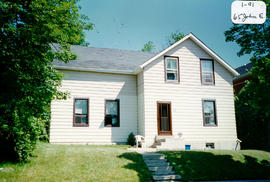- CA BWGPL GJ-HB-2017-04-04-12
- Item
- 1996
Part of George Jackson fonds
The mid-block building located at 65 John St. East was built pre-1900 in the Gothic Revival style. It was the home of Miss Hayes and her two sisters many years ago. They were known for lending money, especially to John Rob and family. The first Dutch family to move to Bradford (in 1925), the Hayes worked on the marsh and owned a greenhouse on Back Street. After the sisters died, the west lot was sold to Vic Turner in 1948.
The 1½-storey, four-bay ‘farmhouse’ has a modified, ‘L’-shaped plan with an off-centre hall and a medium-pitched, gable roof. The single-door entrance is raised slightly above grade level, the steps are not original, and there may have been a verandah originally. Large window openings contain replacement, ground-floor windows. Upper-floor, 2/2 sash windows with plain, wood trim may be original. Wood frame construction is clad with vinyl siding and the building has a parged, stone foundation. The original cladding was probably wood cove siding. According to the 2000 inventory, this modest house has probably not changed significantly since it was built. (1, 2, 3)
George Jackson










